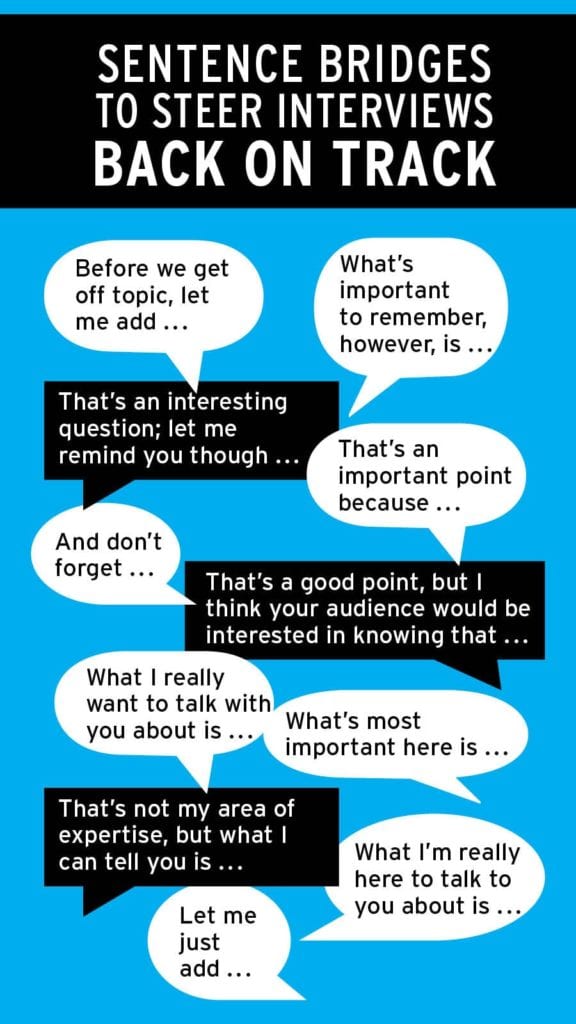
This piece is written with public sector PR pros in mind, yet its advice is universal. For the PR professional in public service, the media are the most powerful resource you have to communicate your message. Particularly during a crisis, media can be your greatest ally and biggest challenge.
Unfortunately, many public sector executives lack the proper training or experience to navigate successfully the ebbs and flows of a crisis while in the public eye.
To handle the unexpected successfully, the public sector executive will need to gain a better understanding of how to best respond to each type of media.
HANDICAPPING REPORTERS
Today the term “media” refers to everyone from a seasoned investigative journalist to weekend bloggers. It’s your responsibility to prepare the executive for what to expect from different types of reporters as well as how to handle a crisis briefing when there’s a huddle of different media types.
Reporters have different motivations, from scooping the competition on a controversial topic to providing a public service to increasing ratings and selling more advertising. Despite their many differences, reporters are alike in that they are searching for an angle, the bottom line, facts that make sense and stories that sell and get web hits.
> Television: TV reporters usually are looking for an immediate hit. Most are assigned stories the same day, if not moments before the interview, and will lack much background about the topic they are covering, especially the complicated details. You should assume the reporter and audience know nothing about your agency or the crisis.
It’s advisable to conduct a pre-interview with TV reporters before putting your executive on camera. This will shorten the interview time, limit interaction and keep you in control of the message. Remember—there typically are only eight to 12 seconds in a TV sound bite. Make those seconds count. Coach your executive to talk within the confines of a sound bite to help him/her remain on-point during the interview.
While the interview is being conducted, have your executive listen carefully to the reporter’s entire question without answering. Most people tend to listen to half the question and then prepare their response during the second half, which is when the important part of the question usually is asked. Ask the reporter to repeat the question if needed. Always be observant: auditing reporters’ non-verbal cues will help during one-on-one interviews. It also will help during crisis briefings with a full media throng.
> Newspapers and magazines: Print reporters usually have longer deadlines and tend to develop more in-depth stories than other mediums. They often have subject knowledge, background information and a specific beat. This is especially true when dealing with reporters covering government. Develop long-term relationships with them.
I always try to break stories with complicated proactive messaging through my contacts on the print side. These stories typically get picked up after publication and repurposed in other mediums. I recommend teaching your executive bridging techniques before interviews with print reporters to help steer the conversation [ see chart ]. Prepare the executive with background information on various issues to be ready for potential side topics.
I also encourage time limits, as interviews can run longer than anticipated if not kept in check by a timekeeper.
> Internet news and blogs: The Internet reporter’s job is to bring information immediately to as many people as possible. If the Internet reporter is a part of a print news organization, he/she usually will work completely apart from print reporters and have different motivations.
News blogs tend to reprint or replay previously aired/printed stories and publish briefs of 100 or fewer words that link back to an original news source. The reporter may or may not call for fact confirmation about what is published. In most instances, I encourage the public affairs professional to remain the main interview subject for this medium, developing messaging points and quotes for key staff and relaying that information to the reporter.
Many executives in the public and private sector will shun the need for training, especially without a crisis looming. It’s your job to make sure they understand that crisis and media training are necessary to prepare for the inevitable. Help executives identify their communications weaknesses and ultimately improve their presence in front of an audience and the media.
(This article is an excerpt from PR News’ Book of Crisis Management Strategies & Tactics Vol. 8. To order a copy, please go to prnewsonline.com/prpress.)
CONTACT: Lauren Hansen is communications project manager at PRR. She can be reached at [email protected]
This article originally appeared in the June 8, 2015 issue of PR News. Read more subscriber-only content by becoming a PR News subscriber today.

